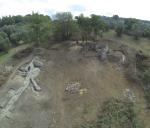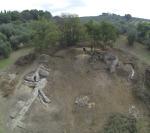Summary (English)
The second campaign of archaeological investigations in the monumental area of Cures Sabina_ by UCLovain, in collaboration with the Archaeological Superintendency of Lazio, aimed to complete the feasability study for a future excavation on the site. It was decided to make a 3D survey of the standing structures; the main aim was to produce an accurate and metrically correct documentation of the walls, both in the horizontal, planimetric, and the vertical components. Image-based mapping techniques were used, based on algorithms of structure-form-motion and stereo multi-view. These methods allow the three dimensional data to be extracted automatically from a set of un-calibrated digital photographs, thus it is possible undertake very accurate mapping in the field in much less time than when using traditional photogrammetry and laser scanning.
Furthermore, the removal of the vegetation around the mid-imperial bath complex revealed a c. 15 m long stretch of wall, perhaps of late date, but above all, of difficult interpretation, partly because it was never published although excavated in the 1980s. The runs of the imposing complex, built using a particular mixed technique (bricks and ashlar blocks of local stone) were completely surveyed using a total station and will be published shortly.
Lastly, a 50 m2 trench was opened in the area where 19th century documentation records that Lanciani’s excavations identified the presence of an opus spicatum floor to the east of the so-called apodyterium of the baths, a zone entered via an opening in the back wall, with a marble threshold. Once the removal of the trees and the detritus that had accumulated in the area over the last 30 years was completed it was possible to check the reliability of this source and evaluate the suggestion that the bath building continued to the east.The season concluded with a campaign of aerial photography using a drone, in order to obtain photographic material for study and a film of the state of preservation of the entire archaeological area.
- Marco Cavalieri - Université catholique de Louvain, Faculté de Philosophie, Arts et Lettres, Centre d'étude des Mondes Antiques
Director
Team
- Agnese Lodi- Scuola di Specializzazione in Storia dell’Arte, Alma Mater - Università di Bologna
- Antonia Fumo
- Chiara Leporati- Fondazione Dià Cultura
- François-Dominique Deltenre- École française d’Athènes
- Giacomo Cacciatore
- Lucia Orlandi- Alma Mater Università di Bologna
- Sara Lenzi- Università degli Studi di Firenze
- Charles Bossu- Academia Belgica - Roma
- Pierre Assenmaker-UCLouvain
- Alessandro Novellini
Research Body
- Université catholique de Louvain
Funding Body
- Université catholique de Louvain






![Download [PDF]](/excavation/skins/fasti/images/results/download_sml.png)







